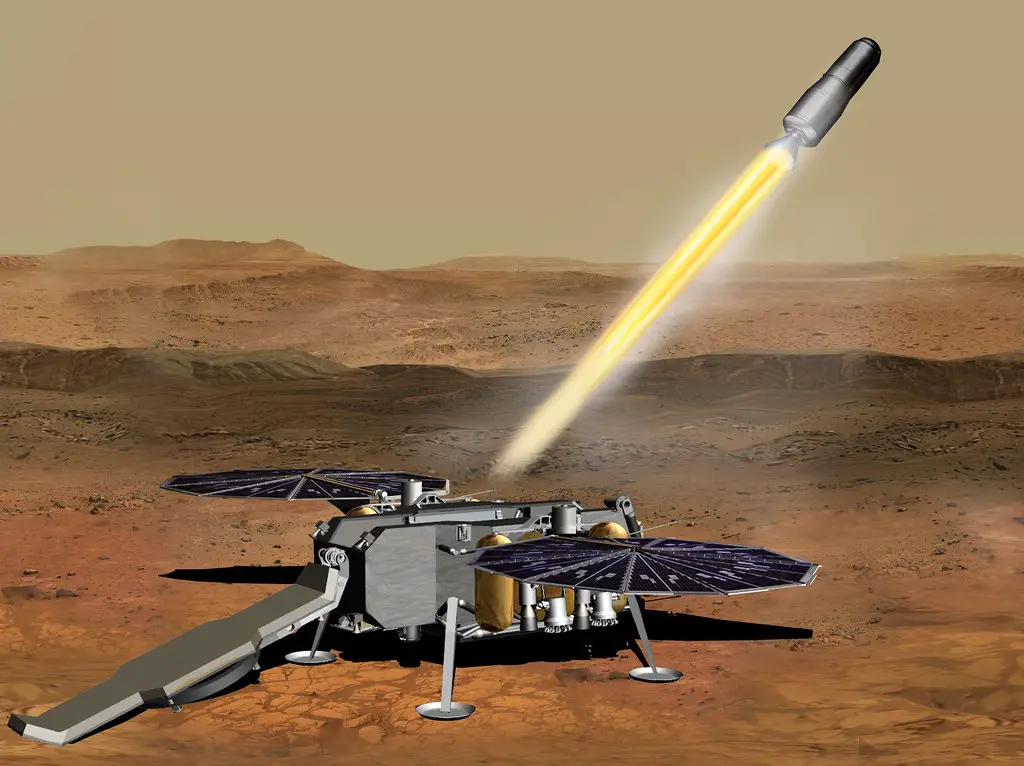The goal of NASA’s ground-breaking and very ambitious Mars Sample Return (MSR) program is to collect and return samples to Earth from the Martian surface. This extraordinary project has the potential to completely change our knowledge of the Red Planet by illuminating its conceivable biological and geological past in previously unimaginable ways. Scientists intend to solve the questions that have bewildered us for generations by examining these samples in an effort to learn more about Mars. This mission is an important step forward in our effort to discover the mysteries of our neighboring planet, and it marks a turning point in the history of planetary exploration.
The Mission
The goal of the carefully designed Mars Sample Return (MSR) program is to gather and safely store samples on the red planet through a succession of robotic missions. In the end, these samples will be returned to Earth for in-depth examination and research, offering priceless new perspectives on Mars.
The Sample Retrieval Lander is an essential part of the MSR program, and it is specifically made to land close to or inside the fascinating Jezero Crater. The lander will launch the samples into Martian orbit using a compact but potent Mars ascent rocket, preparing them for their eventual return trip to Earth.
Jezero Crater was selected with special significance. According to scientific theories, this site was immersed in water billions of years ago. This presents a fascinating chance to find signs of microbial life that may have flourished in this extinct aquatic habitat. Investigating this bygone era may offer intriguing new perspectives on the possibility of extraterrestrial life.
NASA’s Perseverance Mars rover is a major participant in the MSR program. This robotic explorer is state-of-the-art and has spent several hours exploring an old lakebed in Jezero Crater. We hope that the materials that Perseverance has gathered will provide important new insights into the Martian environment and its fascinating history, contributing to our growing understanding of the red planet.
The Mars Science Research (MSR) program advances our understanding of the wide universe beyond our home planet and moves us closer to solving the mysteries of Mars with each mission and scientific discovery. It is an amazing project that piques our interest and advances us in our quest for knowledge.
Challenges and Controversies
But recently, NASA’s Mars Sample Return (MSR) program—a pivotal phase in the Red Planet’s exploration—has reached a critical crossroads. The program’s advancement to the subsequent stage of development encountered a hindrance when an impartial assessment revealed possible problems that required attention prior to proceeding. The scientific community has been debating this brief stop, with some experts speculating that other spacecraft advancements may have eclipsed the sample return mission in terms of mission potential.
Concerns have also been expressed about the program’s viability and expense. There have been requests for a reassessment of the entire Mars exploration program following a thorough study of the flagship Mars Sample Return mission plan. These considerations underscore the necessity for a careful appraisal of methods and a potential rethinking of the Mars program as a whole.
Experts are suggesting a more cooperative strategy using worldwide collaborations to exchange resources and expertise in order to address these issues. This might result in a more economical and successful execution of the Mars Sample Return mission. Furthermore, there is a growing consensus regarding the significance of incorporating cutting-edge technology into the curriculum, like robotics and artificial intelligence, in order to boost scientific capabilities and increase success rates.
There is a great chance that the impending Mars Sample Return mission may solve some of the planet’s riddles and broaden our knowledge of the cosmos. The scientific community is optimistic and dedicated to overcoming these obstacles in order to clear the path for further investigations and discoveries, despite the obstacles that stand in the way.
The Future
Despite the multiple hurdles it faces, the Mars Sample Return (MSR) mission holds enormous potential in expanding our understanding of the Red Planet. The MSR program is well-positioned to greatly improve the success of future initiatives by incorporating important lessons learned from the successful Ingenuity Mars helicopter mission, which proved the viability of powered flight in the thin Martian atmosphere.
As NASA’s Perseverance rover approaches the remarkable milestone of 1,000 days of scientific exploration on the Martian surface, it keeps collecting priceless information and understandings about the planet’s geological past, possibility of extraterrestrial life, and habitability. This milestone has been made possible by the rover’s tenacity and resilience, as well as the mission team’s commitment.
The MSR program seeks to recover carefully chosen samples from the Martian surface and return them to Earth for in-depth analysis, building on the successes of persistence and ingenuity. These samples could reveal a great deal about the temperature, geology, and probable existence of ancient life on Mars in the past.
With every step forward, humanity moves closer to comprehending Mars and its mysterious secrets. There is still a great deal of hope and determination that the MSR program will advance and open the door for more missions and discoveries that will solve the secrets of the fascinating Red Planet.
In summary, NASA’s Mars Sample Return program is proof of the insatiable curiosity of people and their quest for knowledge. The project remains a ray of optimism for future interplanetary exploration, in spite of its difficulties.
Sources
- Mars Sample Return – NASA
- Mars Sample Return – JPL
- Scientific American
- ESA
- Space News
- Space News
- Space News
- BBC
![]()
